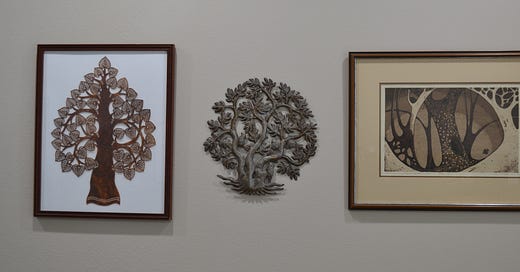For an audio version, click here.
I am a child of the plains. I am a daughter of the trees.
As a daughter of the trees, I have collected art trees for my office wall. “Tree of Life” is a tree cut from tanned leather. The Tree of Life is an archetype in many traditions. As part of the Judeo-Christian tradition, I am reminded Adam and Eve were banned from Eden and from the Tree of Life after they disobeyed God by eating from the Tree of Knowledge of Good and Evil. The leather Tree of Life reminds me of paradise lost.
“Oil Drum Tree” is cut and hammered from a recycled oil drum. Its birds remind me of the turtledove who cooed from a nest near me when, as a child, I sat in tree branches safely hidden from passers-by.
“Tree Holes” is a sepia screen print in which the viewer gazes through a giant tree hole at a series of other tree holes.
In childhood, lying in a hammock between two trees, I sometimes wondered about the prairie trees. Did box elder trees produce box elder bugs? Did ash trees have that name because of their gray bark? Why did mulberry trees so often grow in farm fence lines? In that hammock, I met my childhood friends: Beezus, Nancy Drew, the Bobbsey Twins, and the Boxcar Children.
One of those trees also supported a sack-swing. Clinging to a rope, the sack swing between my knees, I arced beneath the branches. I thrilled with both weightless excitement and fear.
Creating a leaf collection for a high school biology course, I met trees up close and personal. I learned about deciduous trees that shed their leaves, and evergreens which keep their needles year-round. I learned about simple and compound leaves, about lobed and serrated ones. And I met trees by name: quaking aspen, paper birch, American elm, red maple. . . . I learned that vibrant fall colors were present in tree leaves year-round; the colors simply became visible when the chlorophyll vanished.
Our assigned goal was to collect 50 varieties of leaves and needles. An overachiever, I exceeded the goal and collected 70, pressing them flat inside the pages of our “Books of Knowledge” encyclopedia set, then gluing them to sheets of typing paper and stacking them in a covered box. A peppery smell wafted from the box each time I opened it. I kept the collection for a decade before I finally parted with it. By that time its leaves were crumbling and colorless.
The trees of the plains are a different breed than the trees of the mountains or the woods. In the mountains the trees grow gnarled and squat, desperately sucking life from the rocks. In the woods they grow straight and narrow, fighting for sunlight by growing leaves only on their topmost branches. On the plains, trees stand alone. Like the prairie trees that surrounded me, I grew up feeling solitary and alone. Books and trees were my best friends.
Seated at my office keyboard, the solitary writer the solitary child became, I gaze again at the trio of artworks on my office wall.
“Tree Holes” was created by my junior high art teacher Elinor Noteboom, and it was our first purchase of original art work, early in our marriage. Elinor introduced me to the Impressionists who remain among my favorite painters. I can still hear her voice describing the work of Monet and Manet. I hear again the pain in her voice as she talked about the loneliness of being a working mother in the decades of stay-at-home moms.
I remember the bustling Phnom Penh market where we purchased “Tree of Life.” We toured Cambodia on a learning trip to see first-hand the work of World Renew, a service organization dedicated to sustainable development in underdeveloped countries. I am reminded that the Tree of Life reappears in the book of Revelation as part of a new paradise.
I look at “Oil Drum Tree” and picture the Haitian artist hammering the oil drum flat and cutting it with a hammer and chisel. I think of Work of Our Hands, the fair-trade store where I volunteer as part of a network of first-world citizens assisting artisans in the global south with finding markets for their products.
I think again of those solitary trees on the plains. I see the bees that pollinate them, the sun that shines on them, the rain that waters them, the birds that eat and spread their seeds.
No, the trees of the plains are not alone.
I think of the teachers who shaped me, the Cambodian World Renew staff member to whom I teach English via Zoom, my fellow volunteers at the Work of Our Hands, and the group of four women I’ve met with weekly for thirty years.
As a daughter of the trees, I am no longer alone. Perhaps I never was.
If you don’t already subscribe, do so and you won’t miss a single issue. (You can choose the free option.)
If you enjoyed this, share the pleasure (please) . . .
If you’d like to respond. . .




